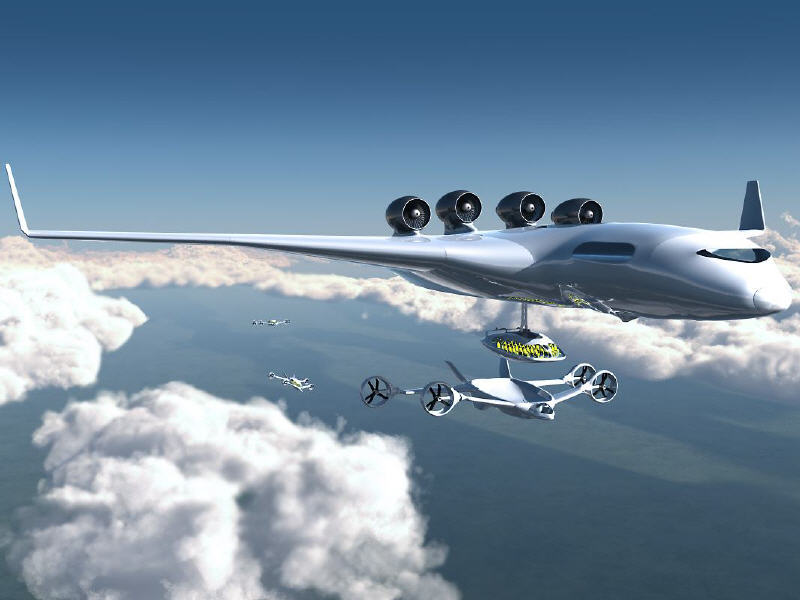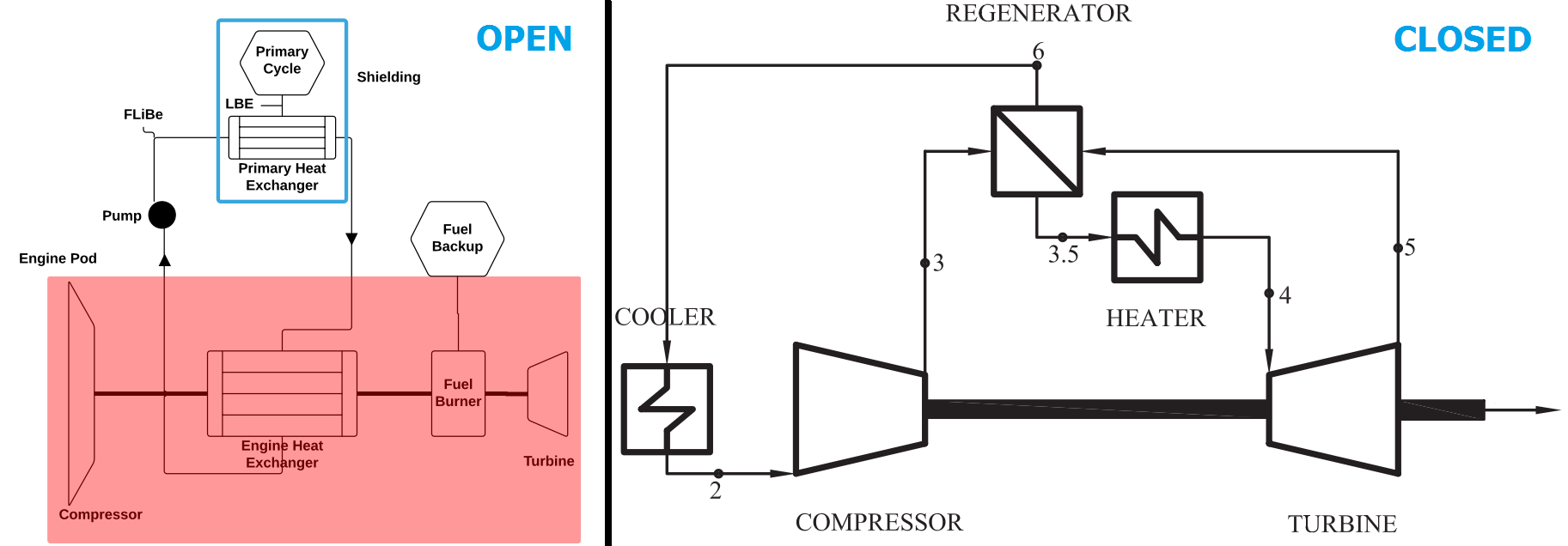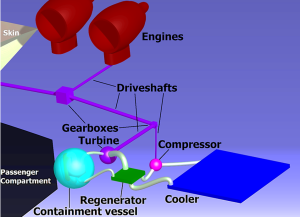Could the RECREATE cruiser fly us into the future?
A thorough rethinking in the working of the aircraft industry is required to cope up with diminishing fossil fuel reserves, including aircraft design, propulsion systems and operation,. The European Commission sponsors the RECREATE research project to investigate the cruiser-feeder set-up, in which cruise-optimized aircraft stay aloft for extended periods while feeder aircraft transport passengers between airports and the cruiser. This study focuses on the design of a cruiser aircraft that uses nuclear power to transport up to 1000 passengers.
A nuclear-powered passenger aircraft requires extensive safety considerations to be operated with minimal danger to its passengers as well as the environment. Even though the Cold War era, research produced some design options for nuclear aircraft, new research is required to assess this concept’s feasibility in the aircraft industry’s near future. The EU-funded RECREATE project has initiated the research, which resulted in a preliminary layout for the cruiser aircraft (La Rocca et al., 2013). It includes the placement of the passenger cabin as well as the passenger transfer system in a blended wing body (BWB) aircraft powered by four big engines, as shown in Figure 1. However, weight estimation of the propulsion system that converts reactor power into propulsion proves to be a major hurdle in assessing the feasibility of the cruiser design. Within the 1 million kg weight budget that has been set in the RECREATE project, 200,000kg are reserved for this system, which is known as the heat cycle. The ability of the cruiser design to be feasible within this weight budget is selected as the main indicator of feasibility in this research. Therefore, this study sets out to design a weight optimized propulsion system, for which various heat cycles are being considered and thoroughly analyzed.

Heat cycle design choices
The heat cycle design process starts by determining the reactor coolant, which is selected to be molten Lead-Bismuth Eutectic (LBE) because of its inherent radiation shielding and heat transfer properties. The heat from this primary fluid is transferred to a secondary cycle, outside of the shielding vessel to generate propulsive power. Three options are investigated for this secondary cycle: an open cycle using a molten Fluorine-Lithium-Beryllium salt (known as FLiBe) as a working fluid, and two variants of closed cycle using supercritical CO2, one with a regenerative and one with a recompression set-up. Supercritical CO2 offers the possibility to design high efficiency cycles even at limited temperatures, as well as minimized compressor and turbine sizes and thereby weights (Dostal, 2004).
The open cycle uses the secondary fluid to heat the airflow through the engine pod in a similar fashion as a conventional combustion chamber, the difference being that the secondary fluid through a heat exchanger supplies the heat. The closed cycle functions as a power station with the secondary fluid eventually driving a turbine, which on the nuclear cruiser is linked to the fan of the engine through driveshafts and gearboxes. Schematics of both options are shown in Figure 2, which shows the regenerative closed cycle. The recompression cycle uses an additional compressor and regenerator to achieve higher cycle efficiency. Because of high-temperature corrosion issues, the use of LBE limits the achievable output temperature, which causes a decrease in achievable thrust and efficiency for the open cycle option. Therefore, the open cycle proves to be inapplicable for the cruiser using an LBE primary circuit. Thus, this study focuses on the closed cycle options.

The nuclear cruiser is equipped with a hybrid propulsion system to operate during take-off and landing, when nuclear propulsion is considered too dangerous as well as technically challenging to provide sufficient thrust. This hybrid propulsion system uses chemical fuel to power the engine and is used to propel the aircraft in case the nuclear power system has to be switched off during cruise. To minimize the weight of the reserve fuel carried by the cruiser, the nuclear system is split into two parts, with a nuclear reactor vessel in each wing root and a separate heat cycle for each of the reactors. If one of the two cycles experiences trouble, the other cycle can still run to provide 50% of the necessary cruise power, with the back-up fuel providing the rest.
Heat cycle design process
To come up with preliminary sizing results, the optimization process is initiated by a grid search, in which the weights of the heat cycle components are minimized for a distinct set of cycle input parameters. The input parameters include heat exchanger dimensions as well as overall heat cycle efficiency and maximum temperature. The latter two parameters are used to simulate the thermodynamic cycle characteristics using a specialized thermodynamic calculation code for supercritical CO2 cycles (Noriega, 2012). The heat cycle components considered in this study are the heat exchangers (like regenerator and cooler), which are all printed circuit heat exchangers (PCHE), and the piping that connects the components. This assumption leaves turbo machinery (compressors and turbines) and driveshafts to be optimized in other studies.
The outcome of the grid search provides the starting point for the overall optimization that comes up with the final minimum weight heat cycle. In this process, cycle and component efficiencies are combined with the physical weight of the system by means of a reactor power weight penalty to form the optimization objective function. The optimization therefore results in a minimum total weight of the heat exchangers and piping in a maximum efficiency thermodynamic cycle, along with the component dimensions and cycle inputs that generate this result. These dimensions are then used to verify that the cycle components fit in the space in the wing that has been reserved for the heat cycle in the RECREATE preliminary design.
Optimization results

In the grid search, the regenerative cycle’s reduced number of components and lower mass flow causes it to come out as the lighter of the two remaining options. After the optimization, the minimum weight cycle has an overall thermodynamic efficiency of 45.4% using a maximum pressure of 60.5MPa. The CO2 cooler, using air as the cooling fluid, proves to be the biggest weight contribution. This is to be expected given the poor heat transfer properties of air, calling for a large heat transfer surface area (and thus heat exchanger volume and weight). The overall cycle weight resulting from the optimization process is 65,600kg. The layout of the respective heat cycle components is found in Figure 3, in which the skin of the aircraft is hidden to show the position of the heat exchangers, piping, and other propulsion system components. The achieved cycle weight leaves a budget of 34,400kg for the systems that have not been sized, such as the compressors and turbines.
Due to the lack of additional data, a reliable statement of the feasibility cannot be made. However, considering the size of typical CO2 turbo machinery, the 34,400kg is deemed sufficient to warrant a preliminary confirmation that the overall heat cycle weight will remain within the required 100,000kg. This means that the technical feasibility of the nuclear cruiser is confirmed to a limited degree in this research.
Concluding remarks
The design of a nuclear cruiser requires comprehensive additional research and validation before it can actually be flown. Besides the detailed design of the reactor and safety features, the results of this thesis have to be corroborated by further calculations, simulations, and experiments. Nevertheless, this research has provided an important initial assessment of nuclear-powered propulsion for civil aviation.
by Thomas Schuwer, MSc. Graduate Aerospace Engineering
References:
- G. la Rocca, M. Li, and M. Chiozzi, “Feasibility study of a nuclear powered blended wing body aircraft for the cruiser/feeder concept”, in CEAS 2013: The International Conference of the European Aerospace Societies, 2013.
- V. Dostal, “A supercritical carbon dioxide cycle for next generation nuclear reactors”, Ph.D. thesis, Massachusetts Institute of Technology, 2004.
- J.B. Noriega, “Design method for s-CO2 gas turbine powerplants”, Master’s thesis, TU Delft , 2012
